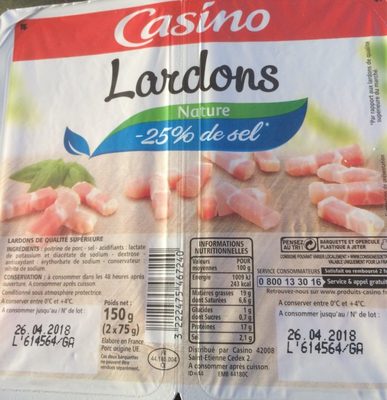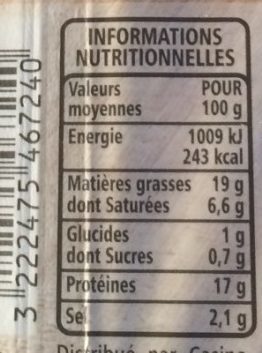Lardons nature 25% de sel en moins - Casino - 150 g
This product page is not complete. You can help to complete it by editing it and adding more data from the photos we have, or by taking more photos using the app for Android or iPhone/iPad. Thank you!
×
Some of the data for this product has been provided directly by the manufacturer casino.
Barcode: 3222475467240 (EAN / EAN-13)
Common name: Lardons de qualité supérieure
Quantity: 150 g
Packaging: Film
Brands: Casino
Brand owner: Casino
Categories: Meats and their products, Meats, Prepared meats, Specific products, Products for specific diets, fr:Charcuteries diverses, Products with reduced salt, fr:Allumettes de porc, Lardons, Plain lardons, Prepared meats with less salt
Traceability code: EMB 44180C - Saint-Mars-la-Jaille (Loire-Atlantique, France)
Stores: Casino
Countries where sold: France
Matching with your preferences
Environment
Carbon footprint
Packaging
Transportation
Other information
Other information: Ces deux barquettes ne peuvent être vendues séparément conditionné sous atmosphère protectrice.Réduit en selElaboré en France. Porc origine UE
Preparation: A consommer après cuisson
Conservation conditions: A conserver entre 0°C et +4°C. A consommer dans les 48 heures après ouverture.
Recycling instructions - To discard: Barquette et opercule plastique
Report a problem
Data sources
Product added on by kiliweb
Last edit of product page on by quentinbrd.
Product page also edited by casino, casino-off, chocapic75, moon-rabbit, openfoodfacts-contributors, org-casino, roboto-app, teolemon, yuka.VjdoZUY1bGNpdmNteHRvODhVamU1T0pMeTVuNEFYNkplL29YSVE9PQ.











